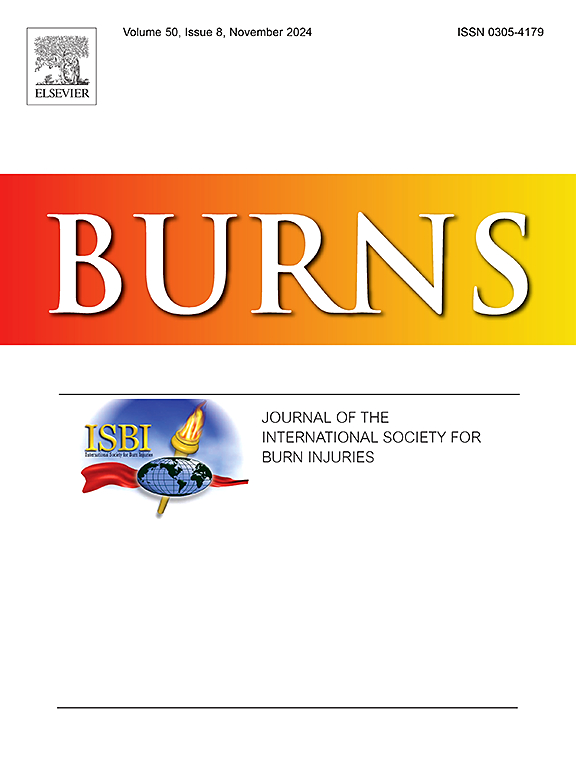Skin tissue regeneration by Acanthus dioscoridis L. leaf extracts in vivo: Relevance to transforming growth factor β 1, antioxidants, and inflammatory factors
IF 2.9
3区 医学
Q2 CRITICAL CARE MEDICINE
引用次数: 0
Abstract
Wound healing is an intricate process that requires special care and therapeutics to enhance skin regeneration. Considering natural products as a safer choice, the present investigation elucidated the phytochemical, acute toxicity, and wound-healing effects of Acanthus dioscoridis L. (LEAD) leaf extracts on excisional neck injury in rats. A uniform dorsal neck cut was formed in twenty-four albino rats, which were arbitrarily divided into 4 groups and treated daily (0.2 ml) with either normal saline (group A); intrasite gel (group B); LEAD 250 and 500 mg/kg of LEAD (groups C and E, respectively).
Phytochemical profiling of LEAD showed elevated total phenolic (111.4 and 105.4 mg/g GAE) and flavonoid (78.6 and 63.5 mg/g rutin) contents in ethyl acetate and methanolic extracts, respectively.
LEAD treatment did not cause toxic incidence in rats administered with up to 5 g/kg. The results of the wound trial unveiled increased therapeutic efficacy of LEAD, denoted by accelerated skin tissue regeneration and higher closure proportion compared to vehicle rats. Microscopical screening showed increased tissue hydroxyproline/collagen formation, fibroblast deposition, and reduced inflammatory cell infiltration.
Topical application of LEAD caused positive modulation of transforming growth factor β 1 (angiogenesis) in recovered skin, maintained skin homeostasis, and up-regulated tissue granulation/re-epithelialization. Moreover, LEAD treatment caused a significant down-regulation of ROS formation/oxidative stress in skin tissues (increased endogenous SOD, CAT), as well as lowered lipid peroxidation (MDA) generation. Serum inflammatory chemicals (TNF-α, IL-6, and IL-10) were significantly modulated following LEAD application. This study confirmed the wound healing potential of LEAD, which was mainly linked with its phenolics and flavonoids contents.
刺皮叶提取物在体内的皮肤组织再生:与转化生长因子β 1、抗氧化剂和炎症因子相关
伤口愈合是一个复杂的过程,需要特殊的护理和治疗来促进皮肤再生。考虑到天然产物是更安全的选择,本研究阐明了棘叶提取物对大鼠切除性颈部损伤的植物化学、急性毒性和伤口愈合作用。24只白化病大鼠形成均匀的颈背切口,随机分为4组,每日(0.2 ml)给予生理盐水(A组);局部凝胶(B组);铅250和500 mg/kg铅(C组和E组分别)。铅的植物化学分析表明,乙酸乙酯和甲醇提取物中总酚(111.4和105.4 mg/g GAE)和类黄酮(78.6和63.5 mg/g芦丁)含量分别升高。在给药5 g/kg的大鼠中,铅治疗没有引起毒性事件。伤口试验结果显示,与对照大鼠相比,铅的治疗效果有所提高,表现为加速皮肤组织再生和更高的闭合比例。镜检显示组织羟脯氨酸/胶原形成增加,成纤维细胞沉积,炎症细胞浸润减少。局部应用铅引起恢复皮肤中转化生长因子β 1(血管生成)的正调节,维持皮肤稳态,上调组织肉芽/再上皮化。此外,铅处理导致皮肤组织ROS形成/氧化应激显著下调(内源性SOD、CAT升高),并降低脂质过氧化(MDA)的生成。应用铅后血清炎症化学物质(TNF-α、IL-6和IL-10)显著调节。本研究证实了铅的创面愈合潜力,主要与其酚类物质和类黄酮含量有关。
本文章由计算机程序翻译,如有差异,请以英文原文为准。
求助全文
约1分钟内获得全文
求助全文
来源期刊

Burns
医学-皮肤病学
CiteScore
4.50
自引率
18.50%
发文量
304
审稿时长
72 days
期刊介绍:
Burns aims to foster the exchange of information among all engaged in preventing and treating the effects of burns. The journal focuses on clinical, scientific and social aspects of these injuries and covers the prevention of the injury, the epidemiology of such injuries and all aspects of treatment including development of new techniques and technologies and verification of existing ones. Regular features include clinical and scientific papers, state of the art reviews and descriptions of burn-care in practice.
Topics covered by Burns include: the effects of smoke on man and animals, their tissues and cells; the responses to and treatment of patients and animals with chemical injuries to the skin; the biological and clinical effects of cold injuries; surgical techniques which are, or may be relevant to the treatment of burned patients during the acute or reconstructive phase following injury; well controlled laboratory studies of the effectiveness of anti-microbial agents on infection and new materials on scarring and healing; inflammatory responses to injury, effectiveness of related agents and other compounds used to modify the physiological and cellular responses to the injury; experimental studies of burns and the outcome of burn wound healing; regenerative medicine concerning the skin.
 求助内容:
求助内容: 应助结果提醒方式:
应助结果提醒方式:


